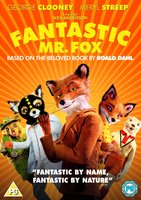
2009 saw Wes Anderson turn his unique eye for detail and style to stop motion animation, with his adaptation of Roald Dahl’s Fantastic Mr. Fox. The film has a distinct and consistent colour scheme of warm oranges and browns, changing only to show the warehouses and homes of the evil farmers Boggis, Bunce and Bean. In contrast to the cosy world of the self-proclaimed ‘wild animals’, the humans live in sterile and lifeless settings. So when a wolf appears towards the end of the film, standing beyond the threshold of this richly textured world where lush fields suddenly become frozen soil, the image is a confusing one. The wolf – the wildest of all the film’s creatures – seems to inhabit a world which more closely resembles that of the mean humans.
The scene sits uneasily with the rest of the film for a number of other reasons. The style of the film’s aesthetic is matched by its fast-paced and witty script, yet here the zingy dialogue is replaced by a louder soundtrack, which has switched from gentle folk to a stark high-pitched soloist. Additionally, the viewer has been informed more than once of Mr Fox’s wolf phobia, so his decision to stop and speak to the creature seems odd, whilst the sincerity of the presentation of the wolf is in itself unusual, when compared with Anderson’s typically self-conscious brand of filmmaking.

The scene certainly leaves us with lots of questions, but when the wolf returns Mr Fox’s gesture of a raised fist, we are at least left with a recognisable symbol of solidarity between their starkly different worlds. In this way, the wolf suggests something of a middle ground for the internal struggles of the title character, who wants both to be wild and adventurous, but also to be a good husband and father. The wolf may have the independence and wildness Mr Fox craves – it is not even clear whether the wolf can use language, which would itself be evidence of domesticity and tameness – but its colours are as alien (and undesirable) to Mr Fox as those of Boggis, Bunce and Bean. The scene sees Mr Fox come to terms with life as it is – having just shown his acceptance and understanding of his ‘different’ son, he recognises not just his own need to express his personal quirks, but everybody else’s, too. The wolf embraces its wildness and accepts its isolation, avoiding the chaos of entering Mr Fox’s world, just as Mr Fox must accept that he will never be truly wild precisely because he cannot, with his young family, accept isolation.
Before meeting it, the wolf was nothing more than an invisible concept to Mr Fox; the word given to his otherwise non-existent fears. Here, the wolf represents the meeting and co-existence of two worlds, where ice and warmth can sit side by side, and where compromise has been successful for our protagonist, the fantastic Mr Fox.
Filmography
Anderson, Wes, Fantastic Mr. Fox, written by Wes Anderson and Noah Baumbach. [DVD]. (London: 20th Century Fox, 2010)